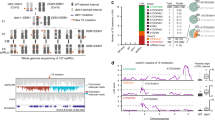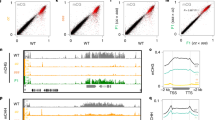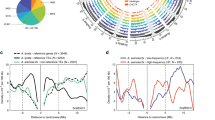Abstract
Transposable elements (TEs) contribute to genome size, organization and evolution. In plants, their activity is primarily controlled by transcriptional gene silencing (TGS), usually investigated at steady states, reflecting how long-established silent conditions are maintained, faithfully reiterated or temporarily modified. How active, invasive TEs are detected and silenced de novo in plants remains largely unknown. Using inbred lineages of hybrid Arabidopsis thaliana epigenomes combining wild-type and mutant chromosomes, we have deciphered the sequence of physiological and molecular events underlying the de novo invasion, proliferation and eventual demise of the single-copy endogenous retrotransposon Evadé (EVD). We show how this reconstructed TE burst causes widespread genome diversification and de novo epiallelism that could serve as sources for selectable and potentially adaptive traits.
This is a preview of subscription content, access via your institution
Access options
Subscribe to this journal
Receive 12 print issues and online access
$209.00 per year
only $17.42 per issue
Buy this article
- Purchase on Springer Link
- Instant access to full article PDF
Prices may be subject to local taxes which are calculated during checkout







Similar content being viewed by others
Accession codes
References
McClintock, B. Controlling elements and the gene. Cold Spring Harb. Symp. Quant. Biol. 21, 197–216 (1956).
Ito, H. et al. An siRNA pathway prevents transgenerational retrotransposition in plants subjected to stress. Nature 472, 115–119 (2011).
Xiao, H., Jiang, N., Schaffner, E., Stockinger, E.J. & van der Knaap, E. A retrotransposon-mediated gene duplication underlies morphological variation of tomato fruit. Science 319, 1527–1530 (2008).
Studer, A., Zhao, Q., Ross-Ibarra, J. & Doebley, J. Identification of a functional transposon insertion in the maize domestication gene tb1. Nat. Genet. 43, 1160–1163 (2011).
Lisch, D. Epigenetic regulation of transposable elements in plants. Annu. Rev. Plant Biol. 60, 43–66 (2009).
Kankel, M.W. et al. Arabidopsis MET1 cytosine methyltransferase mutants. Genetics 163, 1109–1122 (2003).
Matzke, M., Kanno, T., Daxinger, L., Huettel, B. & Matzke, A.J. RNA-mediated chromatin-based silencing in plants. Curr. Opin. Cell Biol. 21, 367–376 (2009).
Zemach, A. et al. The Arabidopsis nucleosome remodeler DDM1 allows DNA methyltransferases to access H1-containing heterochromatin. Cell 153, 193–205 (2013).
Yu, A. et al. Dynamics and biological relevance of DNA demethylation in Arabidopsis antibacterial defense. Proc. Natl. Acad. Sci. USA 110, 2389–2394 (2013).
Slotkin, R.K. et al. Epigenetic reprogramming and small RNA silencing of transposable elements in pollen. Cell 136, 461–472 (2009).
Teixeira, F.K. et al. A role for RNAi in the selective correction of DNA methylation defects. Science 323, 1600–1604 (2009).
Dowen, R.H. et al. Widespread dynamic DNA methylation in response to biotic stress. Proc. Natl. Acad. Sci. USA 109, E2183–E2191 (2012).
Pereira, V. Insertion bias and purifying selection of retrotransposons in the Arabidopsis thaliana genome. Genome Biol. 5, R79 (2004).
Peterson-Burch, B.D., Nettleton, D. & Voytas, D.F. Genomic neighborhoods for Arabidopsis retrotransposons: a role for targeted integration in the distribution of the Metaviridae. Genome Biol. 5, R78 (2004).
Pérez-Hormaeche, J. et al. Invasion of the Arabidopsis genome by the tobacco retrotransposon Tnt1 is controlled by reversible transcriptional gene silencing. Plant Physiol. 147, 1264–1278 (2008).
Liu, B. & Wendel, J.F. Retrotransposon activation followed by rapid repression in introgressed rice plants. Genome 43, 874–880 (2000).
Tsukahara, S. et al. Bursts of retrotransposition reproduced in Arabidopsis. Nature 461, 423–426 (2009).
Mirouze, M. et al. Selective epigenetic control of retrotransposition in Arabidopsis. Nature 461, 427–430 (2009).
Nuthikattu, S. et al. The initiation of epigenetic silencing of active transposable elements is triggered by RDR6 and 21–22 nucleotide small interfering RNAs. Plant Physiol. 162, 116–131 (2013).
Reinders, J. et al. Compromised stability of DNA methylation and transposon immobilization in mosaic Arabidopsis epigenomes. Genes Dev. 23, 939–950 (2009).
Johannes, F. et al. Assessing the impact of transgenerational epigenetic variation on complex traits. PLoS Genet. 5, e1000530 (2009).
Bowman, J.L., Baum, S.F., Eshed, Y., Putterill, J. & Alvarez, J. Molecular genetics of gynoecium development in Arabidopsis. Curr. Top. Dev. Biol. 45, 155–205 (1999).
Nole-Wilson, S., Azhakanandam, S. & Franks, R.G. Polar auxin transport together with AINTEGUMENTA and REVOLUTA coordinate early Arabidopsis gynoecium development. Dev. Biol. 346, 181–195 (2010).
Estrada-Luna, A.A. et al. Beyond promiscuity: from sexuality to apomixis in flowering plants. In Vitro Cell Dev. Biol. Plant 38, 146–151 (2002).
Dunoyer, P. et al. An endogenous, systemic RNAi pathway in plants. EMBO J. 29, 1699–1712 (2010).
Wang, X.B. et al. RNAi-mediated viral immunity requires amplification of virus-derived siRNAs in Arabidopsis thaliana. Proc. Natl. Acad. Sci. USA 107, 484–489 (2010).
Voinnet, O. Use, tolerance and avoidance of amplified RNA silencing by plants. Trends Plant Sci. 13, 317–328 (2008).
Deleris, A. et al. Hierarchical action and inhibition of plant Dicer-like proteins in antiviral defense. Science 313, 68–71 (2006).
Wang, X.-B. et al. The 21-nucleotide, but not 22-nucleotide, viral secondary small interfering RNAs direct potent antiviral defense by two cooperative argonautes in Arabidopsis thaliana. Plant Cell 23, 1625–1638 (2011).
Wu, Q., Wang, X. & Ding, S.W. Viral suppressors of RNA-based viral immunity: host targets. Cell Host Microbe 8, 12–15 (2010).
Voinnet, O., Rivas, S., Mestre, P. & Baulcombe, D. An enhanced transient expression system in plants based on suppression of gene silencing by the p19 protein of tomato bushy stunt virus. Plant J. 33, 949–956 (2003).
Sabot, F. & Schulman, A.H. Parasitism and the retrotransposon life cycle in plants: a hitchhiker's guide to the genome. Heredity 97, 381–388 (2006).
Larsen, L.S.Z. et al. Ty3 capsid mutations reveal early and late functions of the amino-terminal domain. J. Virol. 81, 6957–6972 (2007).
Llorens, C. et al. The Gypsy Database (GyDB) of mobile genetic elements: release 2.0. Nucleic Acids Res. 39, D70–D74 (2011).
Blevins, T. et al. Four plant Dicers mediate viral small RNA biogenesis and DNA virus induced silencing. Nucleic Acids Res. 34, 6233–6246 (2006).
Henderson, I.R. et al. Dissecting Arabidopsis thaliana DICER function in small RNA processing, gene silencing and DNA methylation patterning. Nat. Genet. 38, 721–725 (2006).
Dunoyer, P., Himber, C., Ruiz-Ferrer, V., Alioua, A. & Voinnet, O. Intra- and intercellular RNA interference in Arabidopsis thaliana requires components of the microRNA and heterochromatic silencing pathways. Nat. Genet. 39, 848–856 (2007).
Gasciolli, V., Mallory, A.C., Bartel, D.P. & Vaucheret, H. Partially redundant functions of Arabidopsis DICER-like enzymes and a role for DCL4 in producing trans-acting siRNAs. Curr. Biol. 15, 1494–1500 (2005).
Vaistij, F.E., Jones, L. & Baulcombe, D.C. Spreading of RNA targeting and DNA methylation in RNA silencing requires transcription of the target gene and a putative RNA-dependent RNA polymerase. Plant Cell 14, 857–867 (2002).
Jauvion, V., Rivard, M., Bouteiller, N., Elmayan, T. & Vaucheret, H. RDR2 partially antagonizes the production of RDR6-dependent siRNA in sense transgene-mediated PTGS. PLoS ONE 7, e29785 (2012).
Fojtova, M. Epigenetic switch from posttranscriptional to transcriptional silencing is correlated with promoter hypermethylation. Plant Physiol. 133, 1240–1250 (2003).
Fojtová, M. The trans-silencing capacity of invertedly repeated transgenes depends on their epigenetic state in tobacco. Nucleic Acids Res. 34, 2280–2293 (2006).
Garcia, D. et al. Ago hook and RNA helicase motifs underpin dual roles for SDE3 in antiviral defense and silencing of nonconserved intergenic regions. Mol. Cell 48, 109–120 (2012).
Pontier, D. et al. NERD, a plant-specific GW protein, defines an additional RNAi-dependent chromatin-based pathway in Arabidopsis. Mol. Cell 48, 121–132 (2012).
Stroud, H., Greenberg, M.V.C., Feng, S., Bernatavichute, Y.V. & Jacobsen, S.E. Comprehensive analysis of silencing mutants reveals complex regulation of the Arabidopsis methylome. Cell 152, 352–364 (2013).
Kilby, N.J., Leyser, H.M. & Furner, I.J. Promoter methylation and progressive transgene inactivation in Arabidopsis. Plant Mol. Biol. 20, 103–112 (1992).
Van Houdt, H., Bleys, A. & Depicker, A. RNA target sequences promote spreading of RNA silencing. Plant Physiol. 131, 245–253 (2003).
Kanno, T. et al. Atypical RNA polymerase subunits required for RNA-directed DNA methylation. Nat. Genet. 37, 761–765 (2005).
Vermeersch, L. et al. Transitive RNA silencing signals induce cytosine methylation of a transgenic but not an endogenous target. Plant J. 74, 867–879 (2013).
You, W., Lorkovic, Z.J., Matzke, A.J.M. & Matzke, M. Interplay among RNA polymerases II, IV and V in RNA-directed DNA methylation at a low copy transgene locus in Arabidopsis thaliana. Plant Mol. Biol. 82, 85–96 (2013).
Daxinger, L. et al. A stepwise pathway for biogenesis of 24-nt secondary siRNAs and spreading of DNA methylation. EMBO J. 28, 48–57 (2009).
Wierzbicki, A.T., Ream, T.S., Haag, J.R. & Pikaard, C.S. RNA polymerase V transcription guides ARGONAUTE4 to chromatin. Nat. Genet. 41, 630–634 (2009).
Zheng, Q. et al. RNA polymerase V targets transcriptional silencing components to promoters of protein-coding genes. Plant J. 73, 179–189 (2012).
Vongs, A., Kakutani, T., Martienssen, R.A. & Richards, E.J. Arabidopsis thaliana DNA methylation mutants. Science 260, 1926–1928 (1993).
Saze, H., Scheid, O.M. & Paszkowski, J. Maintenance of CpG methylation is essential for epigenetic inheritance during plant gametogenesis. Nat. Genet. 34, 65–69 (2003).
Xie, Z. et al. Genetic and functional diversification of small RNA pathways in plants. PLoS Biol. 2, E104 (2004).
Xie, Z., Allen, E., Wilken, A. & Carrington, J.C. DICER-LIKE 4 functions in trans-acting small interfering RNA biogenesis and vegetative phase change in Arabidopsis thaliana. Proc. Natl. Acad. Sci. USA 102, 12984–12989 (2005).
Peragine, A., Yoshikawa, M., Wu, G., Albrecht, H.L. & Poethig, R.S. SGS3 and SGS2/SDE1/RDR6 are required for juvenile development and the production of trans-acting siRNAs in Arabidopsis. Genes Dev. 18, 2368–2379 (2004).
Johannes, F. et al. Assessing the impact of transgenerational epigenetic variation on complex traits. PLoS Genet. 5, e1000530 (2009).
Karimi, M., Inzé, D. & Depicker, A. GATEWAY vectors for Agrobacterium-mediated plant transformation. Trends Plant Sci. 7, 193–195 (2002).
Clough, S.J. & Bent, A.F. Floral dip: a simplified method for Agrobacterium-mediated transformation of Arabidopsis thaliana. Plant J. 16, 735–743 (1998.).
Henderson, I.R., Chan, S.R., Cao, X., Johnson, L. & Jacobsen, S.E. Accurate sodium bisulfite sequencing in plants. Epigenetics 5, 47–49 (2010).
Gruntman, E. et al. Kismeth: analyzer of plant methylation states through bisulfite sequencing. BMC Bioinformatics 9, 371 (2008).
Sambrook, J. & Russell, D.W. Molecular Cloning (Cold Spring Harbor Laboratory Press, Cold Spring Harbor, NY, 2001).
Lu, C., Meyers, B.C. & Green, P.J. Construction of small RNA cDNA libraries for deep sequencing. Methods 43, 110–117 (2007).
Pall, G.S. & Hamilton, A.J. Improved northern blot method for enhanced detection of small RNA. Nat. Protoc. 3, 1077–1084 (2008).
Richards, E., Reichardt, M. & Rogers, S. Preparation of genomic DNA from plant tissue. Curr. Protoc. Mol. Biol. Chapter 2, Unit 2.3 (2001).
Qi, Y., Denli, A.M. & Hannon, G.J. Biochemical specialization within Arabidopsis RNA silencing pathways. Mol. Cell 19, 421–428 (2005).
Nakazawa, Y., Hiraguri, A., Moriyama, H. & Fukuhara, T. The dsRNA-binding protein DRB4 interacts with the Dicer-like protein DCL4 in vivo and functions in the trans-acting siRNA pathway. Plant Mol. Biol. 63, 777–785 (2007).
Azevedo, J. et al. Argonaute quenching and global changes in Dicer homeostasis caused by a pathogen-encoded GW repeat protein. Genes Dev. 24, 904–915 (2010).
Schott, G. et al. Differential effects of viral silencing suppressors on siRNA and miRNA loading support the existence of two distinct cellular pools of ARGONAUTE1. EMBO J. 31, 2553–2565 (2012).
Huang, X., Li, J., Bao, F., Zhang, X. & Yang, S. A gain-of-function mutation in the Arabidopsis disease resistance gene RPP4 confers sensitivity to low temperature. Plant Physiol. 154, 796–809 (2010).
Lawton, K.A. et al. Benzothiadiazole induces disease resistance in Arabidopsis by activation of the systemic acquired resistance signal transduction pathway. Plant J. 10, 71–82 (1996).
Waterhouse, A.M., Procter, J.B., Martin, D.M.A., Clamp, M. & Barton, G.J. Jalview Version 2—a multiple sequence alignment editor and analysis workbench. Bioinformatics 25, 1189–1191 (2009).
Langmead, B., Trapnell, C., Pop, M. & Salzberg, S.L. Ultrafast and memory-efficient alignment of short DNA sequences to the human genome. Genome Biol. 10, R25 (2009).
Li, H. et al. The Sequence Alignment/Map format and SAMtools. Bioinformatics 25, 2078–2079 (2009).
Quinlan, A.R. & Hall, I.M. BEDTools: a flexible suite of utilities for comparing genomic features. Bioinformatics 26, 841–842 (2010).
Acknowledgements
We thank members of the Voinnet laboratory for fruitful discussions and critical reading of the manuscript. C. Brosnan is specially thanked for his intellectual input and support all throughout this project. We are indebted to D. Meyer for help with in situ hybridization. We thank L. Navarro (Institut de Biologie de l'Ecole Nomrale Supérieure, IBENS) for providing the LTR:GUS transgenic lines. We thank D. Gilmer (Institut de Biologie Moléculaire des Plantes) for providing antiserum to GFP. This project was supported by a core grant from ETH-Z and a grant from the Swiss National Foundation Genetics of miRNA Action and Biogenesis (31003A_132907). A.M.-O. is supported by a PhD fellowship from the ETH-Z foundation.
Author information
Authors and Affiliations
Contributions
O.V. and A.M.-O. conceived and designed the experiments, helped by V.C. on experiments involving ddm1-mutant epiRILs. A.M.-O., M.E. and A. Martin performed the experiments. O.V., V.C., A.M.-O. and M.E. analyzed the data. A. Marchais performed computer and statistical analyses. O.V. and A.M.-O. wrote the manuscript.
Corresponding author
Ethics declarations
Competing interests
The authors declare no competing financial interests.
Supplementary information
Supplementary Text and Figures
Supplementary Figures 1–10 and Supplementary Tables 1–5 (PDF 8375 kb)
Rights and permissions
About this article
Cite this article
Marí-Ordóñez, A., Marchais, A., Etcheverry, M. et al. Reconstructing de novo silencing of an active plant retrotransposon. Nat Genet 45, 1029–1039 (2013). https://doi.org/10.1038/ng.2703
Received:
Accepted:
Published:
Issue Date:
DOI: https://doi.org/10.1038/ng.2703
This article is cited by
-
Barley AGO4 proteins show overlapping functionality with distinct small RNA-binding properties in heterologous complementation
Plant Cell Reports (2024)
-
The role of LTR retrotransposons in plant genetic engineering: how to control their transposition in the genome
Plant Cell Reports (2023)
-
The RNA-binding domain of DCL3 is required for long-distance RNAi signaling
aBIOTECH (2023)
-
Canalization of genome-wide transcriptional activity in Arabidopsis thaliana accessions by MET1-dependent CG methylation
Genome Biology (2022)
-
Roles of RNA silencing in viral and non-viral plant immunity and in the crosstalk between disease resistance systems
Nature Reviews Molecular Cell Biology (2022)



